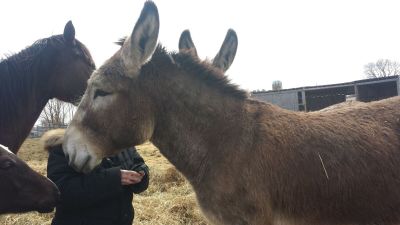

A sweet older donkey whose ears show signs of sunburn and frostbite. At a rural auction in Ontario:
In North America and Europe, donkeys are often used as 'guard' anaimls and are expected to protect livestock from coyotes and wolves. In the Middle East, South America, Mexico, and Africa, they are often used as pack animals and forced to carry loads far exceeding their capacity.
Donkeys have varying strength in their limbs and backs, just like people. They are not designed anatomically to carry large loads. But because of their gentle nature, and their apparent sure footedness, they are often forced to work until they collapse.
The misconception that a donkey is a good 'guard' animal is based on a donkey's keen senses of sight and smell. It is also based on their ability to stand their ground when confronted by something new or dangerous. But at the same time, this misconception exploits a donkey's sense of fear. Donkeys are often loyal to their herdmates and to themselves. When a fox or coyote threatens them, they may react in fear. To take advantage of their sense of fear is exploitative and cruel. What is the solution for people who need a 'guard' animal? Improve the fence around your property. There are some great options in fencing available now.
If you see donkeys with overgrown hooves, or who have no access to shelter, hay, or water, call the local Society for the Protection of Cruelty to Animals immediately. Tell the representative about what you have seen, document the condition of the donkeys. If the donkeys seem in extreme duress, call the police. It is against the law in Ontario to withhold vet care, food, shelter, and water.




Donkey at a rural auction:
This gentle donkey was seen at a rural auction in central Ontario. The rope around his neck is tight and appears to have been on for a long time such that his hair has worn away. Neck ropes such as this are not appropriate ways to 'lead' a donkey. Neck ropes should never be left on a donkey

This baby donkey was filmed at a kill buyer's feedlot on Ontario. Each year Canada slaughters over 50,000 horses and donkeys for meat. The kill buyer told me he sends 'everything' to meat - including donkeys. This meat is consumed in Canada, Europe, and Asia. As equines are different sizes, and are flight animals, the kill box is often confusing, and highly stressful for an animal who is hard to contain and immobilize in order to stun before slaughter. For more information on the predatory business of horse slaughter, please visit the Canadian Horse Defense Coalition's website: www.defendhorsescanada.org
